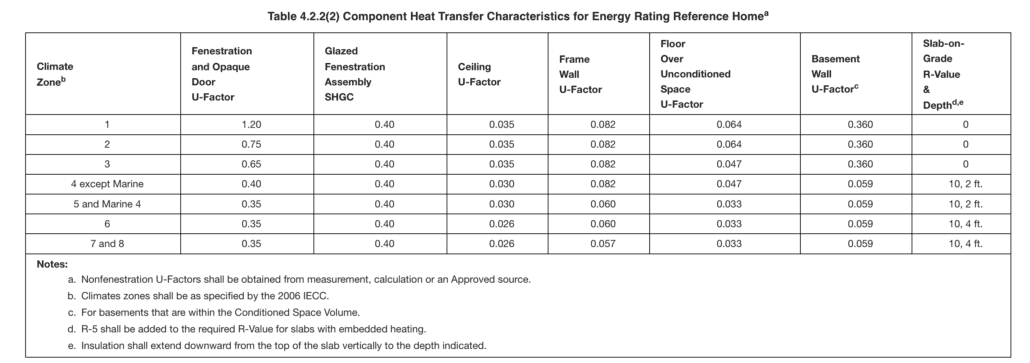When a ‘100’ means something else…
If you’ve had the pleasure of being in or around the Energy Rating Industry for any period of time, you have undoubtedly encountered some misinformation.
Some of it is driven by frequently changing proprietary standards in days past, with it being poorly communicated to the furthest reaches of the industry. I can’t fault people for saying, “You don’t tape to the drywall,” when the provider responsible for informing a Rater of standards updates doesn’t talk to the Rater without being paid in 15 minute increments.
Unfortunately, others are common marketing refrains, like “effective R-value”. In other words – purposeful misinformation. I won’t speak to the intent behind them, whether from ignorance or malice – I don’t know what goes on in other peoples’ heads.
But today we’re going to cut one of these misinformation weeds down (and hopefully pull the roots out – if you help share this).
This is the misinformation we’re slaying today:
“A HERS™ Index [or ERI] of 100 is a code new home, while a 130 is an existing home.”
– Some marketing person
No doubt you’ve seen this repeated somewhere. I’ve come across it more and more as the Energy Rating Industry expands. Sometimes it’s just “100 is new construction”, other times it’s “a standard new house is a 100”.
But this statement is completely false.
Unfortunately, this is a two part statement and I’ll be focused on the first half. Just keep in mind…the second half also has issues.
What’s in a hundred anyways?
It’s worth taking a second to remind ourselves exactly what an ERI (or proprietary calculations like the HERS™ Index) is based on. The short of it – it is a normalized modified end-use load (nMEUL) based calculation. The details are not critical, but in short this dumbs the efficiency of gas appliances down to more easily compare electric and natural gas appliances.
The roots of this were in the “fuel wars” – the architect and organization that promoted this calculation didn’t want to upset either the electric or the oil & gas industries. In the process, everyone lost (Footnote 1).
Part of this calculation meant there had to be a benchmark or reference home to compare the as-built structure against. After all, if you didn’t have a generic home to compare against, you would encounter some significant issues just comparing nMEULs to nMEULs from different rated homes. They can get big, unwieldy, and, frankly, unless you’re a research scientist, a person on the side walk isn’t going to understand what you’re talking about.
Also, you might find that those massive mansions actually use a lot of energy, even after they’ve switched from incandescent to LEDs.
So they had to craft a reference home that would allow homes to be fairly benchmarked against.
Oh – I should also probably mention this was all happening in the lead up to 2006. That’s important.
What does 2006 have to do with anything?
Well, that was when the 2006 IECC was created – which helped usher in a more uniform energy code for authority having jurisdictions (AHJs) to adopt and implement.
It helped even everything out, and create a common language.
Functionally, what the author(s) of the HERS™ Index did was craft a calculation so the Reference Home, based on the 2006 IECC (with modifications from updates to the code), equals a HERS™ Index of 100.
The proof is in the pudding, as the saying goes. And I want to focus on a U-factor table – specifically Table 402.1.1 in the 2006 IECC (Footnote 2).
Look at this table – Climate Zone (CZ) 1 has a maximum allowed u-factor of 1.20. CZ 2 has 0.75. CZ 3 has 0.65. CZ 4 (except marine) has 0.40. CZ 5 (and Marine 4), CZ 6, 7, and 8 has a maximum allowed 0.35.

This table lays the reference home values for the prescriptive and Total U-alternative paths. It also (conveniently) plays a role in a HERS™ Index calculation.
You see – why reinvent the wheel? There’s a table of reference home values that every code official certified by the ICC would recognize, let’s just use that.
Now go to ANSI 301, the baseline calculation for the ERI, which the HERS™ Index is a derivative of.
Specifically, Table 4.2.2(2) Component Heat Transfer Characteristics for Energy Rating Reference Home (Footnote 3).
What’s this?!
CZ 1: U-1.20, CZ 2: U-0.75, CZ 3: U-0.65, CZ 4 (except marine): U-0.40, CZ 5, Marine 4, 6, 7, and 8: U-0.35.

It has been that way since the HERS™ Index was created, and the reference home has not significantly changed since then. That is because when you use a calculation like this, supposedly so you can calculate when you get to “Net Zero”, if you change the reference home to, say, the 2021 U-Factor references, you actually change the goal posts completely. That extends the field beyond reasonability, and makes it a useless metric.
I’ve been living a lie!
While I could sit here and tell you to look through the rest of the tables, comparing the two – I think you understand.
A HERS™ Index 100 is not “new construction”.
A HERS™ Index 100 is actually a 2006 IECC code home.
What should you do with this newfound knowledge?
Stop spreading misinformation!
When you say a “100 is a code new home”, you’re perpetuating a falsehood that demeans that actual levels of construction we see, of the progress we’ve made in the last 15 years. You’re also completely misunderstanding how the HERS™ Index is actually calculated.
Above all – you’re participating in false advertising. It is patently false that a HERS™ 100 is a “new construction” home.
What about the other half of the statement?
Well, you should probably stop saying that, too. While it’s a separate issue for another day, I’ll leave you with this:
There has been no study of homes built prior to 2006 to appropriately estimate the average Index of a pre-2006 built home.
Not one person can actually point to a rigorous study on it.
Anecdotally – my house, built in 1998 clocks in at a HERS™ 104 (ERI 91) (Footnote 4). Other existing homes I’ve rated, like another 1998 built home, came in at the mid-70s.
I know it’s anecdotal and I’m lucky to live in a home built near or better-than the 2006 levels, but it should indicate there are some issues.
How do you actually calculate an Index, anyway?
So what happens now that you have nMEULs for the as-built and the reference home? Easy peasy – you do Equation 4.1-2 from ANSI 301… Which states:
Energy Rating Index = PEfrac * (TnML / (TRL* IAFRH)) * 100
Now, in plain English:
The Energy Rating Index equals the:
- Reference Home end use loads multiplied by the index adjustment factor of the rated home
- (TRL* IAFRH)
- Divide the Rated Home’s nMEULs by the number from Step 1 (circle this number – we’ll come back to it later)
- (TnML / (TRL* IAFRH))
- Subtract the on-site power production from the total energy use of the rated home
- Divide Step 3 by the total energy use of the rated home
- PEfrac – encompasses Step 3 and Step 4
- Multiply the circled number from Step 2 by the number you got in Step 4
- Multiple Step 5 by 100
You’ve now calculated an Energy Rating Index!
Footnotes
- Of course, times have changed – they recently added more calculations to create a CO2e Index, which measures the carbon use of the fuel at the home (with some source energy modifications). This, as you imagine, weighs heavily in favor of an electrified future. Guess they’ve finally picked a winner, eh?
- Page 19: https://codes.iccsafe.org/content/IECC2006/chapter-4-residential-energy-efficiency
- Table 4.2.2(1): https://codes.iccsafe.org/content/RESNET3012019P1/4-energy-rating-calculation-procedures-
- If you’re curious about why the ERI value is different from the HERS™ Index value, you should also wonder why the standards development organization in charge of the 301 calculation modifies the American National Standard Institute (ANSI) Standard and passes it off as the “gold standard” through their proprietary standards. In other words, my suggestion is you should be requesting an ERI calculated in accordance with the ANSI Standard, rather than a proprietary calculation. And any program referencing a proprietary calculation should step back and clarify exactly why they aren’t basing the program on the ANSI Standard.
PLEASE NOTE: Any use of “RESNET®” or other registered trademarks by Building Science Institute, Ltd. Co. does not indicate ownership, sponsorship, or endorsement by the registered trademark owners. Any use of registered trademarks falls under informational, editorial, or comparative use.


